MaryAnn Bernal's Blog, page 180
April 26, 2015
Some fun facts about Guardians of Cridhe blogger Fiona Mcvie
 Fiona Mcvie interviews authors on her Ladies of the Guardians of Cridhe blog, which is how we met (click on the link to read my interview).
Fiona Mcvie interviews authors on her Ladies of the Guardians of Cridhe blog, which is how we met (click on the link to read my interview).
 Fiona was kind enough to share some interesting bet you didn't know stuff about her life. She is a 51-year-old mother and grandmother who loves to read and bake. Now, down to the good stuff:
Fiona was kind enough to share some interesting bet you didn't know stuff about her life. She is a 51-year-old mother and grandmother who loves to read and bake. Now, down to the good stuff:
 Fiona was born in Germany since her dad was in the British Army, so she moved about a lot.
Fiona was born in Germany since her dad was in the British Army, so she moved about a lot.
 Lives in Scotland UK.
Lives in Scotland UK.
 Is part Irish as her ancestors came to Scotland from Ireland in 1707.
Is part Irish as her ancestors came to Scotland from Ireland in 1707.
 Writes poems for fun.
Writes poems for fun.
 Loves long walks with her dog called Fly; he is 19-years-old.
Loves long walks with her dog called Fly; he is 19-years-old.
 Reads between 5 and 10 books a month.
Reads between 5 and 10 books a month.
 Mum to two daughters, two sons and a granny to four.
Mum to two daughters, two sons and a granny to four.
 Has interviewed over 2000 authors on her blog.
Has interviewed over 2000 authors on her blog.
 To find out more about Fiona, kindly visit: Blog: www.authorsinterview.wordpress.com Contact: inspirationforum@hotmail.co.uk
To find out more about Fiona, kindly visit: Blog: www.authorsinterview.wordpress.com Contact: inspirationforum@hotmail.co.uk
Published on April 26, 2015 08:03
Discovery of Pictish Fort Reveals Iron Age Look-Out post for Sea Raiders
 Ancient Origins
Ancient OriginsIn the fifth or sixth century AD, Picts on the eastern Scotland coast set up a fort on a stone outcrop just offshore, possibly to hold sway over the seas. The ancient people had a reputation for ferocity and were one reason the Romans never established a lasting presence in what is now Scotland.
The fort on what is called a “sea stack” may have been one of a series of forts along the coast, archaeologist Gordon Noble of Aberdeen University told the Press and Journal. This particular fort, near Stonehaven, may have been a precursor to medieval Dunnottar Castle, just a few hundred meters (yards) away, on a headland onshore.
 Dunnottar Castle, Scotland (
Wikimedia Commons
)Excavations by Professor Noble and his team showed the fort was inhabited for extended periods, so it may have been an important place to the Picts.
Dunnottar Castle, Scotland (
Wikimedia Commons
)Excavations by Professor Noble and his team showed the fort was inhabited for extended periods, so it may have been an important place to the Picts.“The Picts were known as sea raiders and forts like this may have helped cement that naval power. It is quite an impressive site. It was pretty hairy climb to get up there and at high tide it is completely cut off. Resupplying the fort when it was inhabited would have been a challenge,” Professor Noble told the Daily Mail .
The Romans called Picts “Pictii” because they painted themselves blue when going into battle. No one knows what the Picts called themselves. They lived in east and north Scotland during the late Iron Age and early in the medieval era. They overran Roman positions several times by 200 AD and kept the Romans at bay in Scotland north of the Clyde and Forth.

A Pict looking out to sea as depicted in a 19th century book ( Wikimedia Commons )“The Roman name ‘Pictii’ means “painted ones,” and the Romans believed the Picts were little more than naked savages. However, it is now thought that this is an exaggeration. Given Scotland’s climate, it is unlikely that the Picts spent a lot of their time undressed. It is believed that they wore clothes colored with natural dyes and used leather for footwear and jackets. The Picts were also thought to be excellent farmers, growing crops and keeping animals for food and clothing. Certainly, horses were important to the Picts as they are depicted on many of their carved stones,” says an article at the BBC website.

“The Painted Ones”: Hand-colored version of Theodor de Bry’s engraving of a Pict woman ( Wikimedia Commons )Picts didn’t have writing, so what we know of them comes from ancient Greek and Roman texts and archaeological digs like the one at Dunnicaer sea stack.
The fort on the sea stack at Dunnicaer became known after youngsters climbed it and found rocks with markings on them. They threw some of the rocks into the sea, but one boy went back and retrieved one from the water, the Daily Mail says.

Stone with Pictish carving found at Dunnicaer hill fort (The team from the University of Aberdeen’s Northern Pict Project excavated what may have been a house and a hearth with some charcoal intact at the site. The house was inside the fort.
Noble speculated that there was a community living on the shore near the sea stack, but he said because Picts built their homes from wood it is not possible to find remains of their dwellings.
A professional rock climber scaled the sea stack and put ropes in place for Professor Gordon and his team, who did a five-day excavation at the site.
Featured image: View over Dunnicaer Promontory Fort from the neighboring clifftops. Credit: Les Hamilton.
Published on April 26, 2015 06:30
Rare Bronze Owl Brooch Found on Danish Island
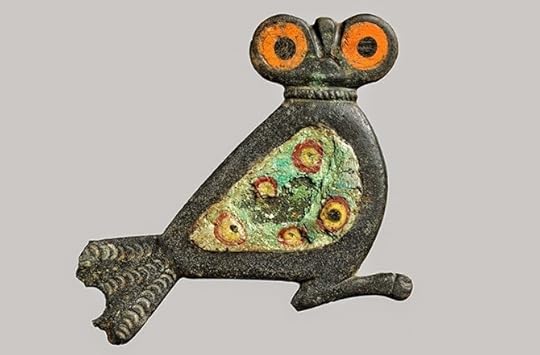 Discovery News
Discovery NewsArchaeologists excavating an Iron Age settlement on the Baltic island of Bornholm in Denmark have unearthed a unique enameled bronze clasp.
Cast as a flat piece of bronze and decorated with green enamel and glass disks in brilliant red, yellow, and black colors, the brooch is shaped like an owl and dates between 100-250 A.D.
“The bird’s big black glass pupils seem to stare directly back at you,” Ulla Lund Hansen, a leading scholar in the field of Roman Iron Age research, and Christina Seehusen, archaeologist at Bornholm Museum, wrote in the Danish archaeology magazine Skalk.
Viking Jewelry Unearthed in Denmark
“Its large, luminous eyes are made even more dramatic by the stunning inlays of orange glass around the pupils,” she added.
The rare brooch, which measures just 1.5 by 1.5 inches, would have been used to fasten a man’s cloak. It was found in the Roman-age soil deposits of an ancient house in September 2014, but only now the find was made public.
“It is very uncommon to find such items in a settlement context in Denmark. We usually find these things only in burials,” Seehusen told Discovery News.
“The settlement was unusual in itself, as it was extremely well preserved compared to typical standards,” she said.
Indeed, on the settlement site Seehusen’s team found very well preserved remains of workshops, pottery, traces of houses and other buildings.
Photos: Iron Age Fashion
“We found Roman coins representing Faustina the Younger [the Empress consort to Marcus Aurelius (161-175 AD)] a bronze spur, several dress pins, bronze and iron brooches, glass beads, iron smelting cinders and plenty of animal bones from pig, cattle, horse, bird, fish and dog,” Seehusen said.
The brooch, or fibula, was probably made along the Roman frontier that ran along the Danube and the Rhine in what is now Germany.How it ended up on Bornholm, an island in the middle of the Baltic Sea, remains a mystery.
“We can only guess who the original owner was and how it came to be preserved on the island,” Seehusen said.
The unusual piece represents a personal item, which is very rarely found outside the borders of the Roman Empire. It was possibly owned by a person who served as a mercenary in the Roman army in the northern provinces.
With its unusal shape and bright colors, it probably provided its owner with a great level of prestige.
“Perhaps it was lost or maybe it was deliberately hidden for reasons known only to its owner. Most likely, we will never know the brooch’s full story,” Seehusen said.
Video: What Ancient Wine Tasted Like
Flat brooches made in various designs were popular between the 1st and 4th century A.D. Their shapes reminded common objects such as axes, spears, wheels, shoes, mythical creatures such as sea serpents and animals including horses, dogs, bees, deers, boars, lions and various types of fish and birds.
Owls were a symbol of wisdom, portrayed as companions to both Athena, the Greek Goddess of war, and Minerva, the Roman goddess of wisdom, art, trade, and war. The owl was one of the rarest types of animals depicted on brooches.“It is possible that Germanic mercenaries in the Roman territories somehow adopted Roman traditions of symbolic jewellery,” Seehusen said.
The majority of such clasps was found in frontier forts in what is now Germany, but small numbers were also found in various European countries.
“They are nonetheless extremely rare in Northern Europe,” Seehusen said.
The brooch has been now restored and is currently on display at the National Museum of Denmark in Copenhagen.
Published on April 26, 2015 06:20
History Trivia - The miraculous image in Our Lady of Good Counsel appears in Genazzano, Italy
April 26
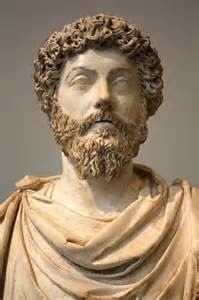
121 Marcus Aurelius (Roman Emperor 161-180) was born. He was the last of the "Five Good Emperors", and is also considered one of the most important Stoic philosophers.
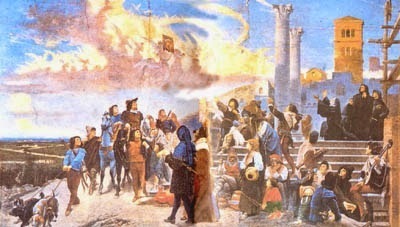
1467 The miraculous image in Our Lady of Good Counsel appeared in Genazzano, Italy.

1514 Copernicus made his first observations of Saturn.

121 Marcus Aurelius (Roman Emperor 161-180) was born. He was the last of the "Five Good Emperors", and is also considered one of the most important Stoic philosophers.

1467 The miraculous image in Our Lady of Good Counsel appeared in Genazzano, Italy.

1514 Copernicus made his first observations of Saturn.
Published on April 26, 2015 00:30
April 25, 2015
Discovery of Reindeer Antlers in Denmark may Rewrite Start of Viking Age
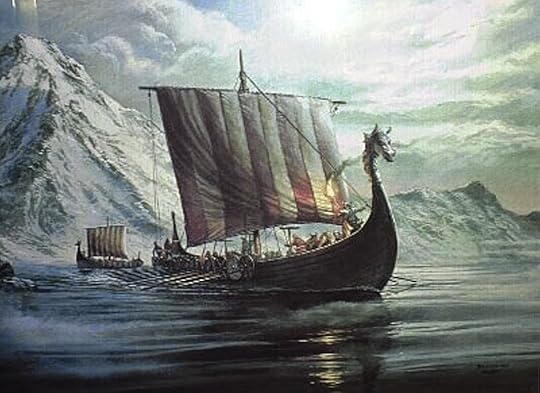 Ancient Origins
Ancient OriginsA team of scholars says their new research is rewriting when and where the Viking age began. The official date for the start of Viking voyages was a 793 AD raid in England. But researchers say people from Norway sailed to Ribe, Denmark, on peaceful missions much earlier—around 725 AD.
Archaeologists from the University of Aarhus in Denmark and the University of York in the United Kingdom found the useful commodity of Norwegian reindeer antlers buried in the earliest archaeological layer of Ribe’s old market. Ribe was the first commercial city in Denmark.
 This caribou with its magnificent rack in Alaska is the same species called reindeer in Scandinavia. (Photo by Dean Biggins/
Wikimedia Commons
)The sailing trips from Norway to Denmark helped the sailors establish the technology and skills necessary to do the later military raids and long-distance voyaging the Vikings did, they say.
This caribou with its magnificent rack in Alaska is the same species called reindeer in Scandinavia. (Photo by Dean Biggins/
Wikimedia Commons
)The sailing trips from Norway to Denmark helped the sailors establish the technology and skills necessary to do the later military raids and long-distance voyaging the Vikings did, they say.“Ultimately, the researchers agree that the discussion of when the Viking era began is also one of semantics,” says an article in ScienceNordic. “It all depends on what you mean by Vikings. Morten Søvsø from Southwest Jutland Museums suggests that we should be careful with the labels we give to people who lived in the past. ‘They didn’t go around knowing they were Vikings. If you want to argue that the Viking age in fact started when they had contact with the wider world, then this study supports this view—but it will always be a rationalisation,’ says Søvsø.”
New study shows Viking women accompanied men on voyages to colonize far-flung lands Norsemen transformed international culture, manufacturing, tech and trade during Viking Era New study reveals Vikings could navigate after dark using sun-compass and mythical sunstone Another researcher, James Barrett of Cambridge University in England, told ScienceNordic he’s not convinced the people who sailed to Ribe in the early eighth century were Vikings, though he says it’s valuable research.
“Where we do not necessarily agree entirely is in the perception of whether towns and trade also helped to start the Viking age," says Barrett, a specialist in medieval archaeology.
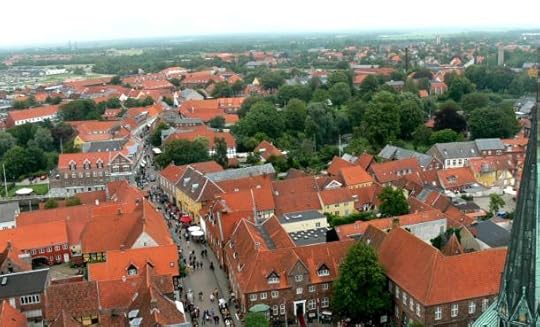 Ribe is Denmark’s oldest commercial center. It looks much different in this photo than it did when Norwegians came around 725 AD to trade reindeer antlers. (Photo by Wolfgang Sauber/
Wikimedia Commons
)There is a related debate among Nordic archaeologists—whether Ribe was central to Viking society early in Viking history. The article in ScienceNordic says it seemed an early link between the oldest commercial center in Denmark and the Vikings would be obvious, but archaeologists had no physical evidence to confirm it.
Ribe is Denmark’s oldest commercial center. It looks much different in this photo than it did when Norwegians came around 725 AD to trade reindeer antlers. (Photo by Wolfgang Sauber/
Wikimedia Commons
)There is a related debate among Nordic archaeologists—whether Ribe was central to Viking society early in Viking history. The article in ScienceNordic says it seemed an early link between the oldest commercial center in Denmark and the Vikings would be obvious, but archaeologists had no physical evidence to confirm it."This is the first time we have proof that seafaring culture, which was the basis for the Viking era, has a history in Ribe. It's fascinating," said Søren Sindbæk, one of the authors of the new study published in the European Journal of Archaeology.
The trips across the Skaggerak Strait or down the North Sea to trade antlers in Denmark may have prepared the Vikings for longer voyages.
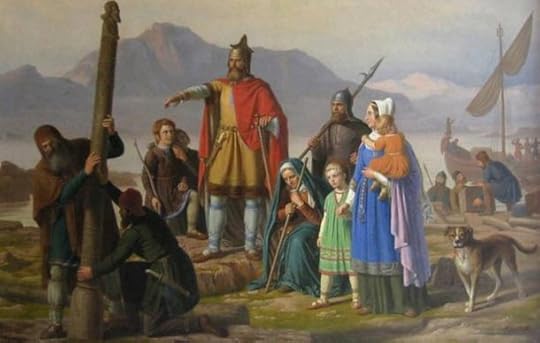 ‘Ingolf tager Island i besiddelse’ by P. Raadsig, 1850, depicting Ingólfr Arnarson, the first settler of Iceland, newly arrived in Reykjavík. (Wikimedia Commons)"The Viking Age becomes a phenomenon in Western Europe because the Vikings learned to use maritime mobility to their advantage,” Sindbæk said. “They learned to master sailing to such an extent that they get to the coast of England where the locals don't expect anything. They come quickly, plunder the unprepared victims, and leave again—a sort of hit and run."
‘Ingolf tager Island i besiddelse’ by P. Raadsig, 1850, depicting Ingólfr Arnarson, the first settler of Iceland, newly arrived in Reykjavík. (Wikimedia Commons)"The Viking Age becomes a phenomenon in Western Europe because the Vikings learned to use maritime mobility to their advantage,” Sindbæk said. “They learned to master sailing to such an extent that they get to the coast of England where the locals don't expect anything. They come quickly, plunder the unprepared victims, and leave again—a sort of hit and run." Model of a Viking age trade ship in the Ribe Viking Museum (Wolfgang Sauber/
Wikimedia Commons
)The Vikings went on to do raids and set up colonies elsewhere in Europe and as far east as Russia. They went on voyages of thousands of kilometers to Iceland, Greenland and Canada.
Model of a Viking age trade ship in the Ribe Viking Museum (Wolfgang Sauber/
Wikimedia Commons
)The Vikings went on to do raids and set up colonies elsewhere in Europe and as far east as Russia. They went on voyages of thousands of kilometers to Iceland, Greenland and Canada."We can now show that the famous Scandinavian sea voyages, which eventually led to the discovery of Iceland and Greenland, have a history of some commercial travel, not just raids. Previously we were inclined to say that yes, once you can sail across open water, you can also sail to the commercial towns -- now we can turn the equation around and say that trading towns may have been an important part of the drive behind developing new technologies, "says Sindbæk said. “The peaceful exchanges—trading—will take up more of the story, and the military voyages, which are also important, must now share the space.”
Deer antlers were important to Danes because they were used in making combs, needles and other tools. A householder was likely able to find enough for home use, but a comb maker may not have been able to. So some Norwegians decided to gather what was for them a waste product and take them to Denmark, where they were a valuable commodity, Sindbæk said.
Featured image: The Vikings were known as great seafarers. They were able to reach lands such as Britain through their mastery of the seas. Image source .
Published on April 25, 2015 12:06
History Trivia - Athens surrenders to Sparta
April 25
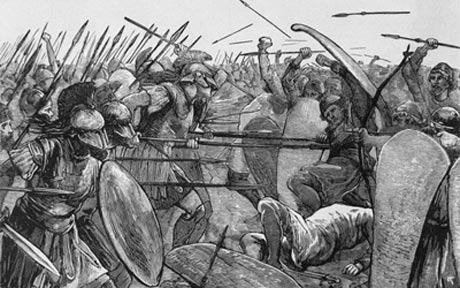
404 BC Athens surrendered to Sparta, ending the Peloponesian War.
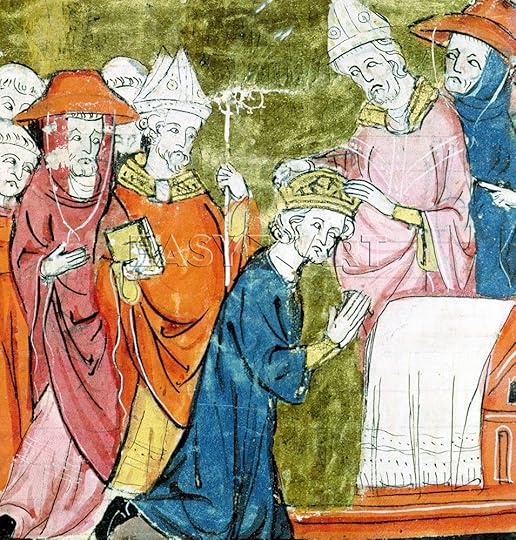
799 Pope Leo III was attacked during a procession in Rome due, in part, for recognizing Charlemagne as patricius of the Romans, which upset the delicate balance between the Byzantines and the west that his predecessor had established. He fled to Charlemagne, who escorted the Pope safely back to Rome where he oversaw a commission that vindicated Leo and deported his enemies. Leo would later crown Charlemagne the first Holy Roman Emperor

404 BC Athens surrendered to Sparta, ending the Peloponesian War.

799 Pope Leo III was attacked during a procession in Rome due, in part, for recognizing Charlemagne as patricius of the Romans, which upset the delicate balance between the Byzantines and the west that his predecessor had established. He fled to Charlemagne, who escorted the Pope safely back to Rome where he oversaw a commission that vindicated Leo and deported his enemies. Leo would later crown Charlemagne the first Holy Roman Emperor
Published on April 25, 2015 02:00
April 24, 2015
History Trivia - Greeks enter Troy using the Trojan Horse
April 24
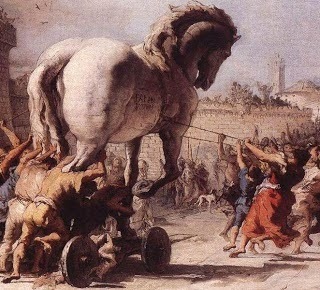
1184 BC The Greeks entered Troy using the Trojan Horse (traditional date).

709 Saint Wilfrid died. A monk of Lindisfarne Abbey and later Bishop of Hexham, Wilfrid spread the Benedictine Rule and worked to establish Roman Catholicism over the influence of the Celtic Church in England.
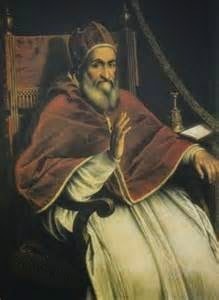
1585 Pope Sixtus V elected. Sixtus was unanimously elected successor to Gregory XIII, who had left the Papal States in disarray. He defined the college of Cardinals and is considered the founder of the Counter-Reformation.

1184 BC The Greeks entered Troy using the Trojan Horse (traditional date).

709 Saint Wilfrid died. A monk of Lindisfarne Abbey and later Bishop of Hexham, Wilfrid spread the Benedictine Rule and worked to establish Roman Catholicism over the influence of the Celtic Church in England.

1585 Pope Sixtus V elected. Sixtus was unanimously elected successor to Gregory XIII, who had left the Papal States in disarray. He defined the college of Cardinals and is considered the founder of the Counter-Reformation.
Published on April 24, 2015 02:00
April 23, 2015
St George’s Day: 10 things you (probably) didn’t know about him
History Extra
 St George slaying the dragon. © Lebrecht Music and Arts Photo Library / Alamy
St George slaying the dragon. © Lebrecht Music and Arts Photo Library / Alamy
St George’s Day is upon us once again, and interest surrounding the festival of England’s primary patron saint shows no sign of abating. It’s common knowledge that, according to legend, St George killed a dragon, but what else do you know about him?
Here, writing for History Extra, Jonathan Good, associate professor of history at Reinhardt University in Georgia, brings you 10 lesser-known facts about England’s patron saint…
1) St George is not EnglishIf he ever existed (and there’s no proof he did), George would likely have been a soldier somewhere in the eastern Roman Empire, probably in what is now Turkey. According to legend, he was martyred for his faith under Emperor Diocletian in the early fourth century, and his major shrine is located in Lod, Israel.
2) His earliest legends were so outlandish that the Pope condemned themEarly Christians were known to exaggerate the tortures endured by their martyrs, but St George is in a league all of his own. According to one source, St George was torn on the rack, hit on the head with hammers until his brains oozed out, forced to drink poison, torn on a wheel, boiled in lead, and much else besides – all over a period of seven years.
A fifth-century decree attributed to Pope Gelasius declared that, lest it give rise to mockery, the details were not be read out in church.
3) He was one of several military saints honoured in the Byzantine EmpireOthers included Theodore, Demetrius, and Mercurius. All of these saints had been soldiers when alive, and continued their patronage of the Byzantine army in death – especially St George, who became the most popular.
Crusaders to the Holy Land in 1099 adopted this tradition of military saints, and brought the veneration of St George back to Western Europe.
4) St George is also connected to agricultureHis name means ‘earth-worker’ – that is, farmer – and his feast day of 23 April is in the spring, when crops are starting to grow. Many people throughout European history have prayed to St George for a good harvest.
5) The dragon was not always a part of St George’s storyThe earliest legend that features St George rescuing a princess from a dragon dates to the 11th century. It may have started simply as a way to explain icons of military saints slaying dragons, symbolising the triumph of good over evil.
For the permanent association of St George and the dragon we have to thank the Golden Legend, a popular collection of saints’ lives written in the 13th century.
6) He is the patron saint of many placesThese include countries like Ethiopia, Georgia and Portugal, and cities such as Freiburg, Moscow and Beirut. George was seen as an especially powerful intercessor, and the dragon story has a universal appeal.
7) St George was known as ‘Our Lady’s Knight’ in medieval EnglandAs a patron of crusading, St George easily became the quintessential knight. And every knight needs to serve a lady – who better than the Blessed Virgin Mary herself?
8) Edward I is ultimately the reason why St George ‘became’ EnglishAs a crusader, Edward I (r 1272–1307) acquired an affinity for St George, and back in England outfitted his troops with the St George’s cross when fighting the Welsh. He raised St George’s flag over Caerlaverock Castle in Scotland in 1300, among other things.
Later, Edward III, hoping to revive the glories of his grandfather’s reign, founded the Order of the Garter under the patronage of St George.
9) St George appeared to the English army at the battle of Agincourt in 1415King Henry V (r 1413–22) was especially devoted to St George, as is reflected in Shakespeare’s play. The idea later arose that St George had actually appeared to the English during the battle of Agincourt in 1415, which was a stunning victory for them against the French.
10) The Reformation was not kind to St GeorgeEven King Edward VI himself mocked the legend as improbable. But the poet Edmund Spenser, among others, kept George’s legend alive as a romantic and nationalistic story. And it is one that shows no signs of losing its appeal.
Jonathan Good’s The Cult of St George in Medieval England (Boydell & Brewer) was recently updated, and is now available in paperback. To find out more, click here.
 St George slaying the dragon. © Lebrecht Music and Arts Photo Library / Alamy
St George slaying the dragon. © Lebrecht Music and Arts Photo Library / Alamy St George’s Day is upon us once again, and interest surrounding the festival of England’s primary patron saint shows no sign of abating. It’s common knowledge that, according to legend, St George killed a dragon, but what else do you know about him?
Here, writing for History Extra, Jonathan Good, associate professor of history at Reinhardt University in Georgia, brings you 10 lesser-known facts about England’s patron saint…
1) St George is not EnglishIf he ever existed (and there’s no proof he did), George would likely have been a soldier somewhere in the eastern Roman Empire, probably in what is now Turkey. According to legend, he was martyred for his faith under Emperor Diocletian in the early fourth century, and his major shrine is located in Lod, Israel.
2) His earliest legends were so outlandish that the Pope condemned themEarly Christians were known to exaggerate the tortures endured by their martyrs, but St George is in a league all of his own. According to one source, St George was torn on the rack, hit on the head with hammers until his brains oozed out, forced to drink poison, torn on a wheel, boiled in lead, and much else besides – all over a period of seven years.
A fifth-century decree attributed to Pope Gelasius declared that, lest it give rise to mockery, the details were not be read out in church.
3) He was one of several military saints honoured in the Byzantine EmpireOthers included Theodore, Demetrius, and Mercurius. All of these saints had been soldiers when alive, and continued their patronage of the Byzantine army in death – especially St George, who became the most popular.
Crusaders to the Holy Land in 1099 adopted this tradition of military saints, and brought the veneration of St George back to Western Europe.
4) St George is also connected to agricultureHis name means ‘earth-worker’ – that is, farmer – and his feast day of 23 April is in the spring, when crops are starting to grow. Many people throughout European history have prayed to St George for a good harvest.
5) The dragon was not always a part of St George’s storyThe earliest legend that features St George rescuing a princess from a dragon dates to the 11th century. It may have started simply as a way to explain icons of military saints slaying dragons, symbolising the triumph of good over evil.
For the permanent association of St George and the dragon we have to thank the Golden Legend, a popular collection of saints’ lives written in the 13th century.
6) He is the patron saint of many placesThese include countries like Ethiopia, Georgia and Portugal, and cities such as Freiburg, Moscow and Beirut. George was seen as an especially powerful intercessor, and the dragon story has a universal appeal.
7) St George was known as ‘Our Lady’s Knight’ in medieval EnglandAs a patron of crusading, St George easily became the quintessential knight. And every knight needs to serve a lady – who better than the Blessed Virgin Mary herself?
8) Edward I is ultimately the reason why St George ‘became’ EnglishAs a crusader, Edward I (r 1272–1307) acquired an affinity for St George, and back in England outfitted his troops with the St George’s cross when fighting the Welsh. He raised St George’s flag over Caerlaverock Castle in Scotland in 1300, among other things.
Later, Edward III, hoping to revive the glories of his grandfather’s reign, founded the Order of the Garter under the patronage of St George.
9) St George appeared to the English army at the battle of Agincourt in 1415King Henry V (r 1413–22) was especially devoted to St George, as is reflected in Shakespeare’s play. The idea later arose that St George had actually appeared to the English during the battle of Agincourt in 1415, which was a stunning victory for them against the French.
10) The Reformation was not kind to St GeorgeEven King Edward VI himself mocked the legend as improbable. But the poet Edmund Spenser, among others, kept George’s legend alive as a romantic and nationalistic story. And it is one that shows no signs of losing its appeal.
Jonathan Good’s The Cult of St George in Medieval England (Boydell & Brewer) was recently updated, and is now available in paperback. To find out more, click here.
Published on April 23, 2015 11:44
New Release - Veetu Industries and Rae Gee: A Second Past Midnight - OUT TODAY!
Veetu Industries and Rae Gee: A Second Past Midnight - OUT TODAY!: In 1981, at the height of the Cold War, a single nuclear warhead sent America's technological capability back to the 18th centur...
 In 1981, at the height of the Cold War, a single nuclear warhead sent America's technological capability back to the 18th century. Four years later, the shattered country is still struggling to put itself back together. Infrastructure has crumbled, the government is gone, and convicted criminals are hunted for food.
In 1981, at the height of the Cold War, a single nuclear warhead sent America's technological capability back to the 18th century. Four years later, the shattered country is still struggling to put itself back together. Infrastructure has crumbled, the government is gone, and convicted criminals are hunted for food.
James lives in a small, Midwestern town. By day, he tends his family's farm, trading the food they grow for other supplies. By night, he dreams of being a musician. But with his world destroyed, music remains a frivolous dream.
That is, until he meets Flame. Convicted of drug dealing, Flame has become a part of the bi-annual Shoot to Kill hunting season. He has a dark past and people want him dead. Yet he has a strong determination to live and shares James' musical dream. James and Flame join forces, traveling first to New York and then to London, in spite of the numerous obstacles in their path and the shadow of death hanging over them. Will they be strong enough to escape it and find their dreams together?
Available from:
Torquere Press
Amazon
Amazon UK
 In 1981, at the height of the Cold War, a single nuclear warhead sent America's technological capability back to the 18th century. Four years later, the shattered country is still struggling to put itself back together. Infrastructure has crumbled, the government is gone, and convicted criminals are hunted for food.
In 1981, at the height of the Cold War, a single nuclear warhead sent America's technological capability back to the 18th century. Four years later, the shattered country is still struggling to put itself back together. Infrastructure has crumbled, the government is gone, and convicted criminals are hunted for food. James lives in a small, Midwestern town. By day, he tends his family's farm, trading the food they grow for other supplies. By night, he dreams of being a musician. But with his world destroyed, music remains a frivolous dream.
That is, until he meets Flame. Convicted of drug dealing, Flame has become a part of the bi-annual Shoot to Kill hunting season. He has a dark past and people want him dead. Yet he has a strong determination to live and shares James' musical dream. James and Flame join forces, traveling first to New York and then to London, in spite of the numerous obstacles in their path and the shadow of death hanging over them. Will they be strong enough to escape it and find their dreams together?
Available from:
Torquere Press
Amazon
Amazon UK
Published on April 23, 2015 05:29
History Trivia - Order of the Garter founded
April 23
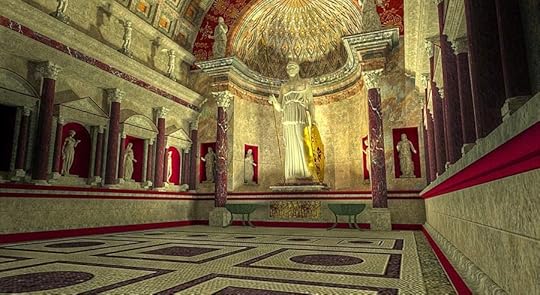
215 BC A temple was built on the Capitoline Hill and dedicated to Venus Erycina to commemorate the Roman defeat at Lake Trasimene.
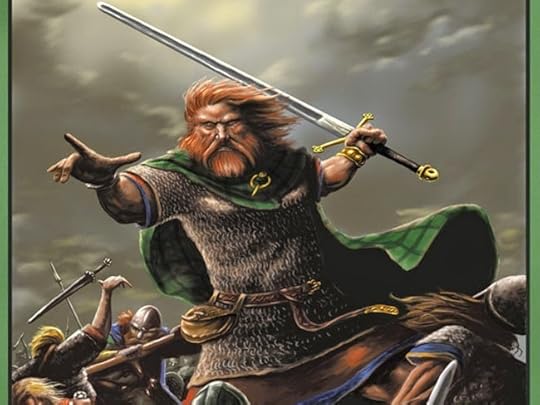
1014 Battle of Clontarf Brian Boru (High King of Ireland in 1002) defeated Viking invaders, but was killed during the battle.

1348 The founding of the Order of the Garter by King Edward III was announced on St George's Day.

215 BC A temple was built on the Capitoline Hill and dedicated to Venus Erycina to commemorate the Roman defeat at Lake Trasimene.

1014 Battle of Clontarf Brian Boru (High King of Ireland in 1002) defeated Viking invaders, but was killed during the battle.

1348 The founding of the Order of the Garter by King Edward III was announced on St George's Day.
Published on April 23, 2015 02:00



